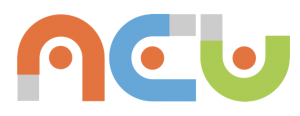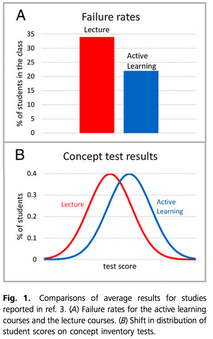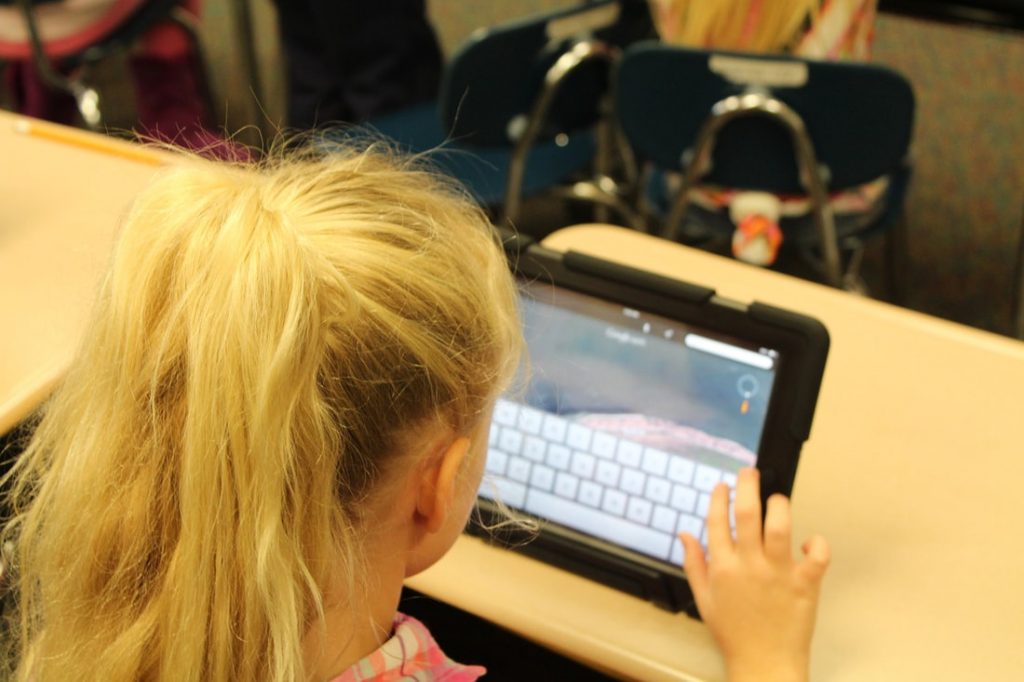
“Our School of Education is savouring the possibilities that virtual and augmented reality… may still bring to ‘learning to teach’”. “Leveraging AI-powered learning platforms will spur an increased usage of personalisation approaches”. Every time a new year arrives we witness a flurry of excitement and attention around education’s new directions.
With increased pressure on educators to improve student performance combined with increasingly disconnected students, schools are desperate for solutions. If technology has enabled business and industry to evolve so radically, why not education?
And so once more, as 2020 gets underway, we see predictions that “we will see schools buying a higher share of school software in 2020”. More money, time and energy will once again be invested into education. However, despite the continued euphoria, there have been numerous report that teaching with technology is not bringing about the learning gains that were expected (Falck, Bulman, Robinson). However, it seems, once again schools and universities are preparing to spend more money on software solutions to education problems.
“Insanity is doing the same thing over and over again and expecting different results.” Surely before we spend billions of Rands, as South Africa’s government has committed to do (State of the Nation), we should take a careful look at what teachers really need when it comes to teaching with technology.
A Correcting Approach
Several years ago, arising out of years of research, I developed the Activated Classroom Teaching (ACT) model. This model is a cohesive set of teaching approaches (pedagogies) that resonate with how modern students learn as well as leveraging the affordances of technology. One of the core pedagogies of the ACT model is the pedagogy of Correction. This is pedagogy looks at how to use technology to encourage learning through correction.
To this end I constantly seek out tools that both support this pedagogy and leverage the affordances of technology. One such tool is AllOurIdeas (www.allourideas.org). While the tool is designed to be used to run surveys, it powerfully illustrates how technology can adopt the correction pedagogy effectively.
Over the years, surveys have been conducted in much the same way. In the “old days” a survey was paper based. You would be asked to complete a survey on paper. Then the invention of the telephone ushered in a new type of survey – the telephonic survey. However, nothing had really changed. The only difference was that your answers were gathered over the telephone and not with you physically filling in the survey. It was still the same type of survey. And then along came the computer. Surely now this amazing technology would transform how surveys took place? And it did. Now you can send the survey via email to the respondent who fills it out online. However, once again nothing’s changed. It’s still the same survey, it’s just delivered and completed in a different way.
This is exactly the same problem we have seen taking place in education. Teachers take technology, use it in the classroom, but at the end of the day nothing has changed. The smart board is the chalkboard. The e-book is the textbook, and so on.
Traditional surveys have two problems. The first is they require a set amount of time. So if you don’t have time to answer the 20 questions the chances are you won’t do the survey. Or if for some reason you are super eager, that makes no difference. There are only 20 questions. Another problem surveys have is that there is often no place for your input into the survey. What if none of the options being offered are one you want to choose? Too bad.
Allourideas.org blended the concept of wikis and their correcting approach with surveys, and created a novel way of completing surveys. The survey presents the respondent with a pair of responses that they can choose between. In addition to being able to choose one of the pair or responses, respondents can also choose to add their own options – thus creating new answer pairs generated by users. They are then presented with another pair of responses. This continues for as long or short as they respondent wishes to continue. This means the survey responds both to the new ideas of people, and hence is correcting, and also allows anyone to participate no matter how little or much time they have.
What do teachers need?
Just over five years ago I began using AllOurIdeas (http://allourideas.org/teaching) to ask teachers to answer the key question we are still struggling to answer – “What do you think is most important for successful technology-based teaching?” To answer this, the respondent is presented with a pair of options and can select the one they feel is most correct, or they can add additional items.
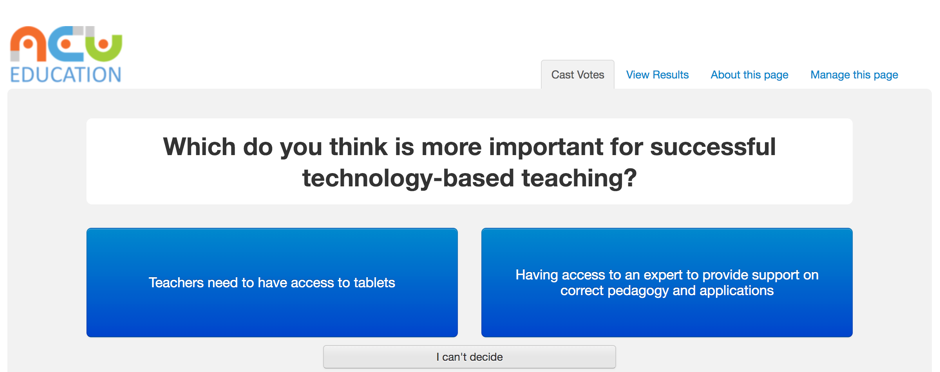
Teachers’ Hierarchy of Needs
The top 10 items provide an important insight into what teachers consider to be important when moving towards technology-based teaching. The score column is the estimated chance that it will win against a randomly chosen idea. For example, a score of 75 means the idea is predicted to be chosen 75% of the time.

Considering these items shows that a range of issues are raised as critical to success. They range from having the basic platform in place, to training, to support, and social aspects. What is particularly interesting is that the top 10 factors align closely with Maslow’s hierarchy of needs.

Maslow’s hierarchy of needs is a model to explain human motivations. Needs lower in the pyramid, such as food, sleep, clothing (Physiological Needs) must be satisfied before higher needs such as respect, self-esteem, and freedom (Esteem Needs). However, when considering the top 10 “needs” for effective teaching with technology, it becomes apparent that a similar hierarchy of needs exists, as depicted below.
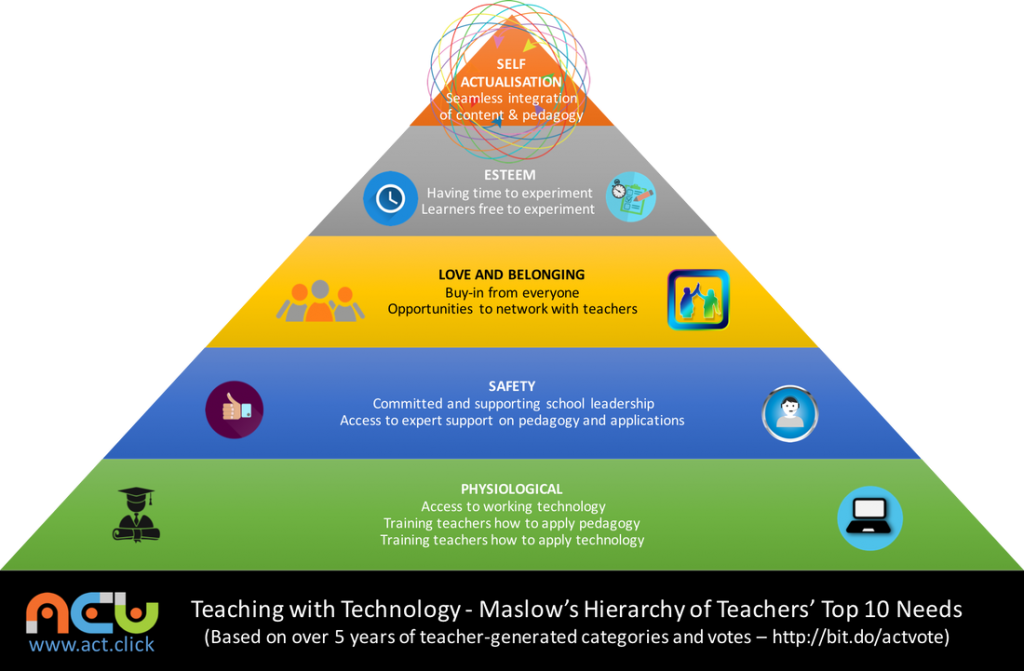
The hierarchy of Teachers Top 10 Needs for effective technology-based teaching spans the same five layers. At the most fundamental (physiological) level we find three key needs – Access to working technology, Training on how to apply pedagogies, and Training on how to apply technology. Without meeting these basic needs, none of the others can be met.
The second layer are the “safety” needs and here are two needs – committed and supportive school leadership and access to expert support on pedagogy and applications.
The third layer are the “love and belonging” needs and much like our needs as humans, teachers require a keen sense of community to be effective at new teaching approaches. As such two key needs identified were buy-in from everyone and opportunities to network with teachers.
The fourth layer are the “esteem” needs and in particular this relates to freedoms to try and do things. Two key needs identified in this layer are teachers having the time and space to experiment with new teaching approaches, and learners also being given time and space to experiment with new ways of learning.
The fifth and highest layer of Maslow’s hierarchy is self-actualisation. This is the pinnacle need where we strive to be the best we can be. In terms of teachers needs for technology-based teaching this need is reflected in the desire to have a seamless integration of content and digital-age pedagogies.
Seeing ahead clearly
2020 is about vision, when we talk about eye-tests, but nowhere is the need to see clearly more imperative than it is in our schools and universities. The pressure to educate increasingly more disconnected students is going to increase. However, simply throwing eye-watering technologies like Virtual Reality, Augmented Reality, Artificial Intelligence at the problem is not going help us see our way clearly. In fact, when the top 10 needs are looked at – software, AI, tablets, VR, etc. are not even mentioned.
If we are going to see clearly in 2020 to address the modern challenges of education, we need to address the 5 key needs of teachers who are passionate about change and new approaches.

Firstly, the basic substratum (physiological) needs must be addressed. Nothing else matters without working technology, which government has begun to address (ref), and appropriate training in technology and more importantly, pedagogy – which is woefully lacking.
Secondly structures must be put in place to provide support to the teachers both from school leadership and experts in technology and pedagogy.
Thirdly, a positive social space needs to be created that encourages school buy-in and spaces for teachers to network.
Fourthly, teachers and students need space – space to make mistakes, to experiment, to try new approaches. Is safe spaces are not created for this take place, just like with all other learning, progress is not going to be made.
Finally, the goal of seamless integration of technology and pedagogy needs to be established whereby all content is supported by underpinning pedagogies and associated, appropriate technologies.
Sawubona (I see you) 2020 – Let’s see clearly!
